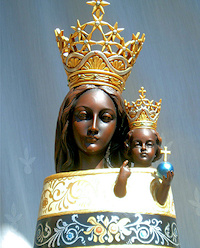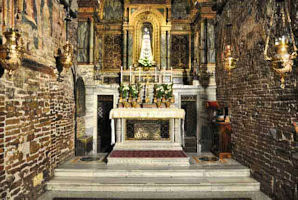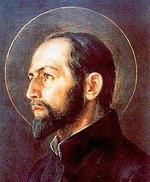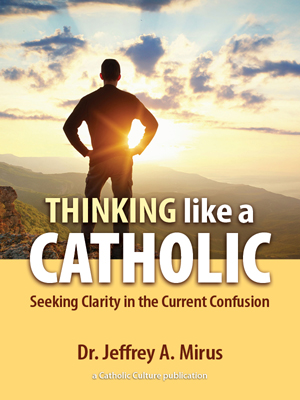The New Advent Feast, Our Lady of Loreto
By Jennifer Gregory Miller ( bio - articles - email ) | Dec 11, 2019 | In The Liturgical Year
My apologies for missing the actual new feast day! My mother-in-law unexpectedly died on Thanksgiving and I’m still recuperating from foot surgery. These make extra factors interfering with my timeliness. But this is a feast to continue our Advent meditations, so I’m still publishing.—JGM
 December 10 of 2019 is the first time that Our Lady of Loreto is celebrated in the General Roman Calendar. On October 7 the decree was pronounced by Pope Francis (although it was published on October 31) to be a reoccurring Optional Memorial for the Universal Church.
December 10 of 2019 is the first time that Our Lady of Loreto is celebrated in the General Roman Calendar. On October 7 the decree was pronounced by Pope Francis (although it was published on October 31) to be a reoccurring Optional Memorial for the Universal Church.
On the surface, it seems odd to universally honor a title for the Blessed Virgin Mary based on a house. We could add it to another of the list of strange things Catholics do. But actually it is a rich title, and very fitting for Advent.
Tradition holds that a small house in Loreto, Italy originated in Nazareth and is the actual home of the Blessed Virgin Mary. The dimensions are very small, one-room measuring 30 x 13 feet. It is composed simply of stones and mortar found in Palestine and hand-chiseled in a style consistent of the time of Jesus. This was thought to be the home of Saints Anne and Joachim, Mary’s parents. The Immaculate Conception occurred in this house. It is here that the Angel Gabriel appeared to Mary, and with her “ Fiat” the Incarnation happened in this very house. This was also the house that the Holy Family lived in Nazareth after returning from their time in Egypt. Jesus lived here until he was 30 and began his public ministry. Here also is where St. Joseph died.
Since apostolic times this house was a place of pilgrimage and worship. In 313 AD Constantine built a basilica around the Holy House of Nazareth to protect it. The basilica was destroyed by the Saracens in 1090, but the Holy House was untouched. Another basilica was built during the twelfth century but this was destroyed by Moslems in 1263 during the Crusades. The Holy House was again unharmed. When the Christians were driven completely out of the Holy Land in 1291, the Holy House disappeared from Nazareth and suddenly appeared in modern day Croatia. It is said that angels transported it. The house was again moved (by angels) on December 10, 1294 (hence the date of the new Optional Memorial), due to the Muslim invasion of Albania. The house landed first in Recanti, Italy, but soon after moved for a third time to its present location in Loreto, Italy.
 Loreto is the final home for this Holy House. There is a large basilica containing the house. The Holy House is covered by marble on the outside facade, but on the inside is the original humble stone and mortar walls. The east wall contains an altar with the inscription: “Hic Verbum Caro Factum Est“ (Here the Word was made flesh). Above the altar is a statue of Our Lady of Loreto. The current statue is a replica of an ancient one made from cedar of Lebanon, one of the so-called “Black Madonnas” due to the burning of candles and incense for hundreds of years. The original statue was destroyed by fire and replaced by another similar statue made from cedar from the Vatican in the 1920s.
Loreto is the final home for this Holy House. There is a large basilica containing the house. The Holy House is covered by marble on the outside facade, but on the inside is the original humble stone and mortar walls. The east wall contains an altar with the inscription: “Hic Verbum Caro Factum Est“ (Here the Word was made flesh). Above the altar is a statue of Our Lady of Loreto. The current statue is a replica of an ancient one made from cedar of Lebanon, one of the so-called “Black Madonnas” due to the burning of candles and incense for hundreds of years. The original statue was destroyed by fire and replaced by another similar statue made from cedar from the Vatican in the 1920s.
Whether we doubt the true origin of the house, or dispute the miraculous traveling of the house to Loreto, and/or dislike the image of the statue of Our Lady of Loreto, this feast day is still pertinent to us. This feast of Our Lady of Loreto is a bridge of the Advent season to Christmas.
The Directory on Popular Piety and the Liturgy points out that the Advent liturgy celebrates Mary “in an exemplary way...it exalts her faith and humility with which she promptly and totally submitted to God’s plan of salvation; it highlights her presence in the events of grace preceding the birth of the Savior.” We just celebrated the Solemnity of the Immaculate Conception, a feast that celebrates Mary’s preservation from original sin at the moment of her conception. Her sinlessness was a necessary preparation for being the Mother of God, which “harmonizes perfectly with many of the salient themes of Advent (Dir. Pop. Piety).” For the feast of Our Lady of Loreto, we are remembering the Blessed Virgin Mary in this Holy House, where the Immaculate Conception and Incarnation both occurred.
Pope Francis in his decree points out:
That sanctuary recalls the mystery of the Incarnation and prompts all those who visit it to consider the fullness of time, when God sent his Son, born of a woman, and to meditate on both the words of the angel in the Gospel and the words of Virgin who answered the divine call. Overshadowed by the Holy Spirit, the humble servant of the Lord has become the house of divinity, the most pure image of the holy Church.
The aforementioned sanctuary, closely linked to the Apostolic See, praised by the Supreme Pontiffs and universally known, has been able to illustrate in an excellent way, over time, no less than Nazareth in the Holy Land, the evangelical virtues of the Holy Family.
It is these key moments that we can dwell on during this season of preparation for the feast of Christmas. We can place ourselves in the scenes of our meditations, go to this little “Casa Santa” or Holy House and think of the great moments of our Redemption.
Even if we put aside all other aspects connected to this feast day, such as the statue of Our Lady of Loreto and a house transported by angels, Our Lady of Loreto is an Advent image of the Blessed Virgin Mary and a wonderful feast addition to the Liturgical Calendar.
Some further information about Our Lady of Loreto:
- For current information for the liturgy for this Optional Memorial, see the USCCB and Liturgy Training Publications.
- Originally composed and prayed at the Basilica of the Holy House of Loreto, the Litany of Loreto, now more commonly known as the Litany of the Blessed Virgin Mary, is often recited at the end of the rosary.
- Visit online the Basilica of the Holy House of Loreto. Unfortunately, the site is only in Italian, but it gives a glimpse of the beautiful sanctuary.
- Was the House of Loreto a flying house, transported by angels? There is a possible rational explanation to the flying house in “Our Lady of Loreto and Aviation.”
- Our Lady of Loreto is the patroness of aviation, so the next plane ride, invoke Mary for a safe trip.
- Since the decree of this celebration is written in Italian, I thought I would share a loose translation of the entire decree. The translation is merged from several online translations, some personal editing and originally from L’Osservatore Romano:
The Celebration of the Blessed Virgin Mary of Loreto in the General Roman Calendar
· Decree of the Congregation for divine worship and the discipline of the sacraments ·
October 31, 2019The veneration for the Holy House of Loreto has been, since the Middle Ages, the origin of that peculiar sanctuary frequented, even today, by numerous faithful pilgrims to feed their faith in the Word of God made flesh for us.
That sanctuary recalls the mystery of the Incarnation and prompts all those who visit it to consider the fullness of time, when God sent his Son, born of a woman, and to meditate on both the words of the angel in the Gospel and the words of Virgin who answered the divine call. Overshadowed by the Holy Spirit, the humble servant of the Lord has become the house of divinity, the most pure image of the holy Church.
The aforementioned sanctuary, closely linked to the Apostolic See, praised by the Supreme Pontiffs and universally known, has been able to illustrate in an excellent way, over time, no less than Nazareth in the Holy Land, the evangelical virtues of the Holy Family.
In the Holy House, before the effigy of the Mother of the Redeemer and of the Church, Saints and Blesseds have responded to their vocation, the sick have called for consolation in suffering, the people of God has begun to praise and beg the Blessed Virgin Mary with the Litany of Loreto, known all over the world. In particular, those who travel by plane have found in her their heavenly patroness.
In light of all this, the Supreme Pontiff Francis decreed with his authority that the optional memory of the Blessed Virgin Mary of Loreto be entered in the Roman Calendar on December 10, the day on which there is a feast in Loreto, and celebrated every year. This celebration will help everyone, especially families, young people, religious, to imitate the virtues of the perfect disciple of the Gospel, the Virgin Mother who, conceiving the Head of the Church, also welcomed us with Him.
The new memorial must therefore appear in all the Calendars and Liturgical Books for the celebration of Mass and the Liturgy of the Hours; the relative liturgical texts are attached to this decree and their translations, approved by the Episcopal Conferences, will be published after the confirmation of this Dicastery.
Despite anything against it.
From the headquarters of the Congregation for Divine Worship and the Discipline of the Sacraments,
7 October 2019, in memory of the Blessed Virgin Mary of the Rosary.Robert Card. Sarah, praefectus
Arthur Roche, Archbishop Secretary
All comments are moderated. To lighten our editing burden, only current donors are allowed to Sound Off. If you are a current donor, log in to see the comment form; otherwise please support our work, and Sound Off!








